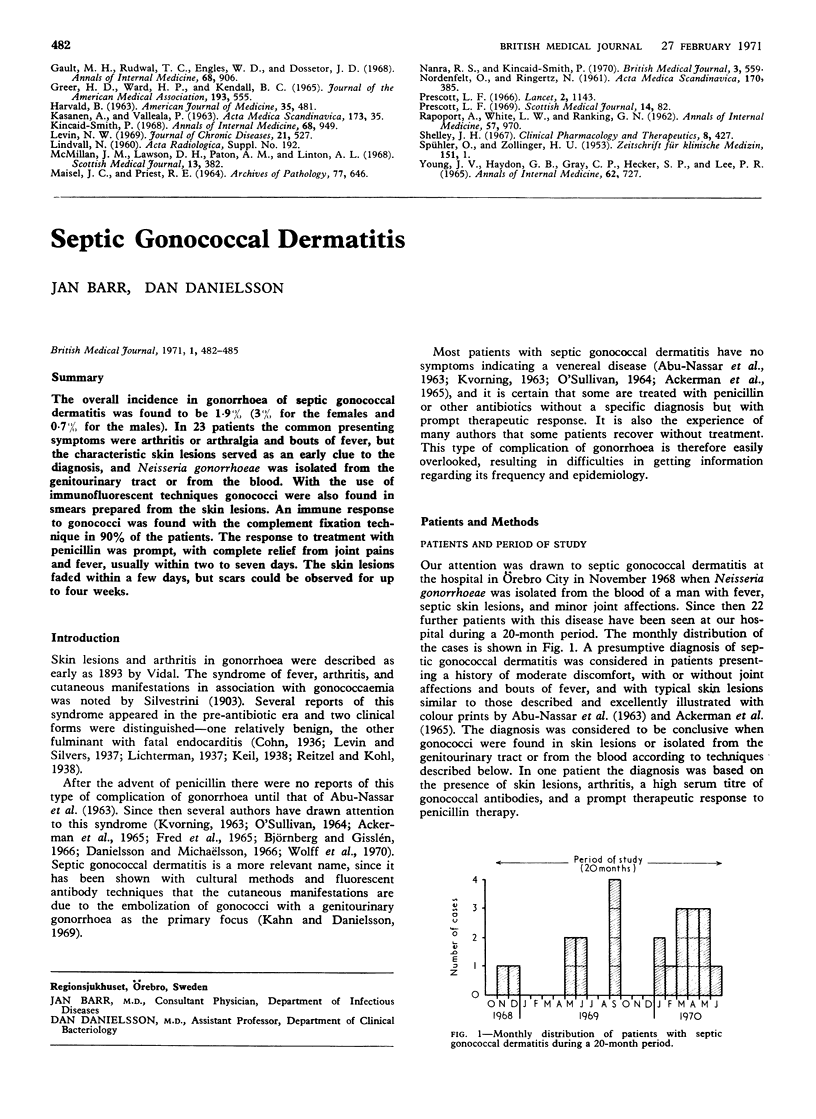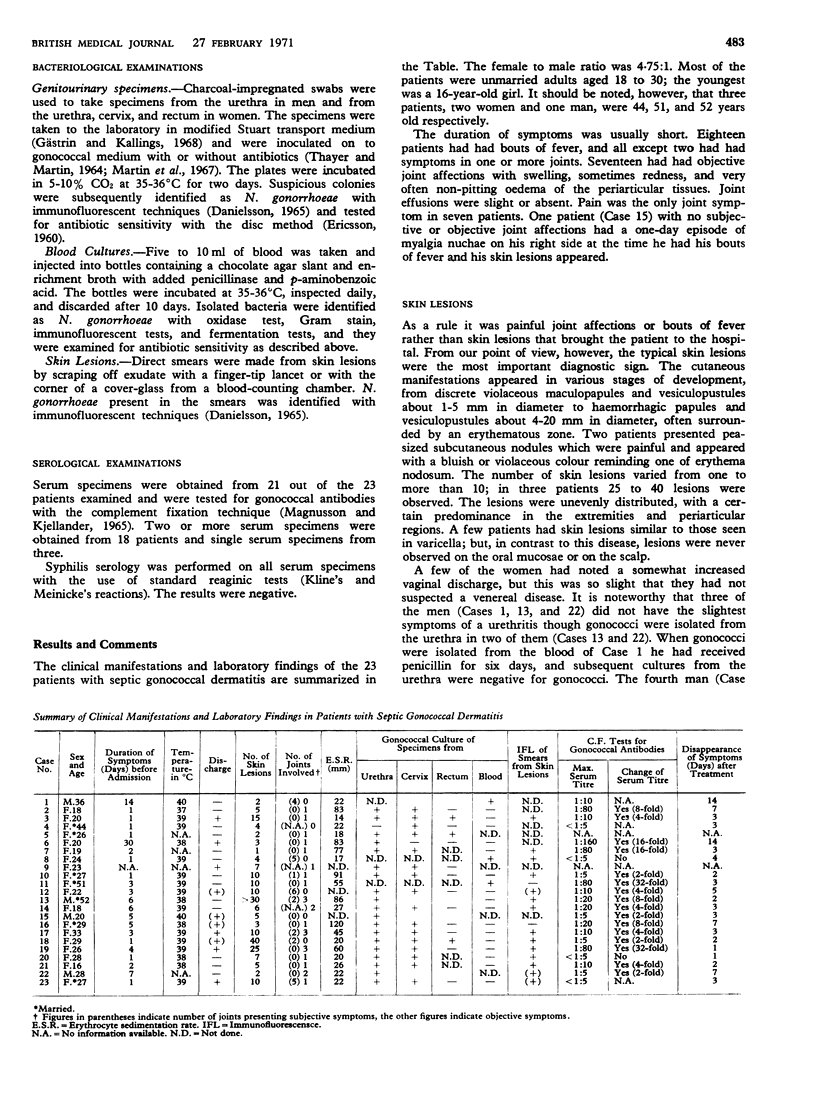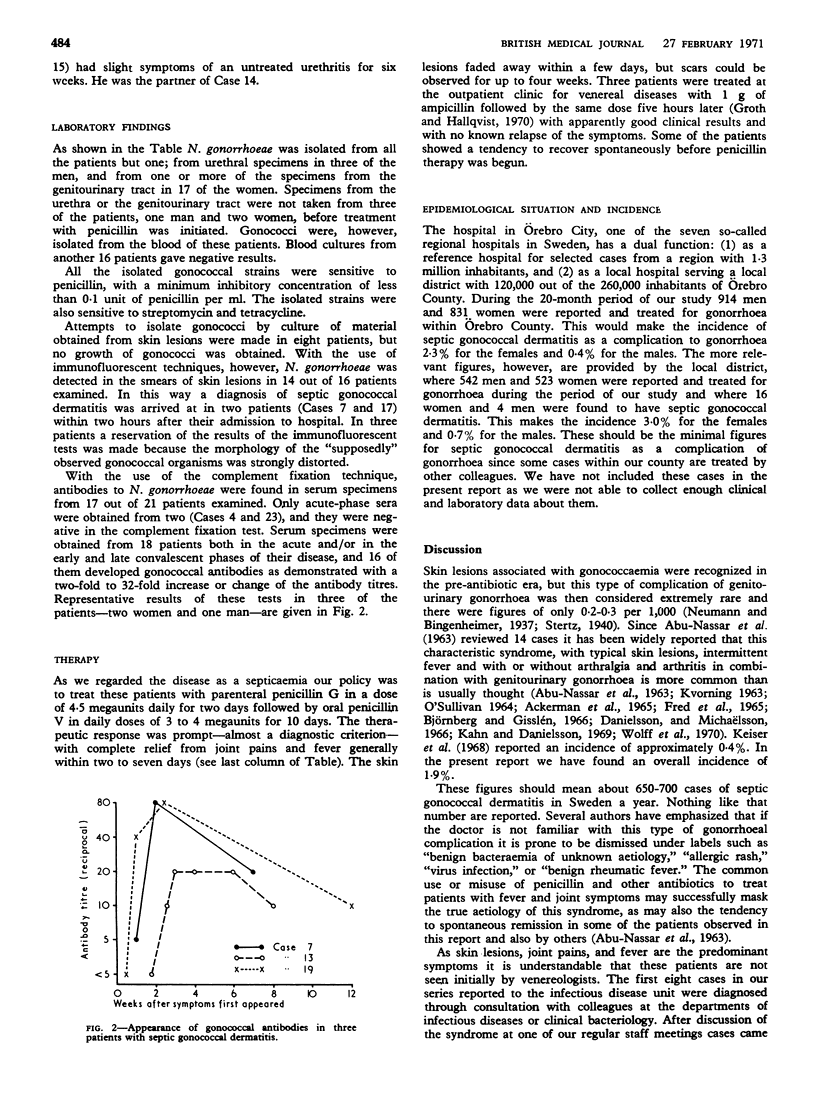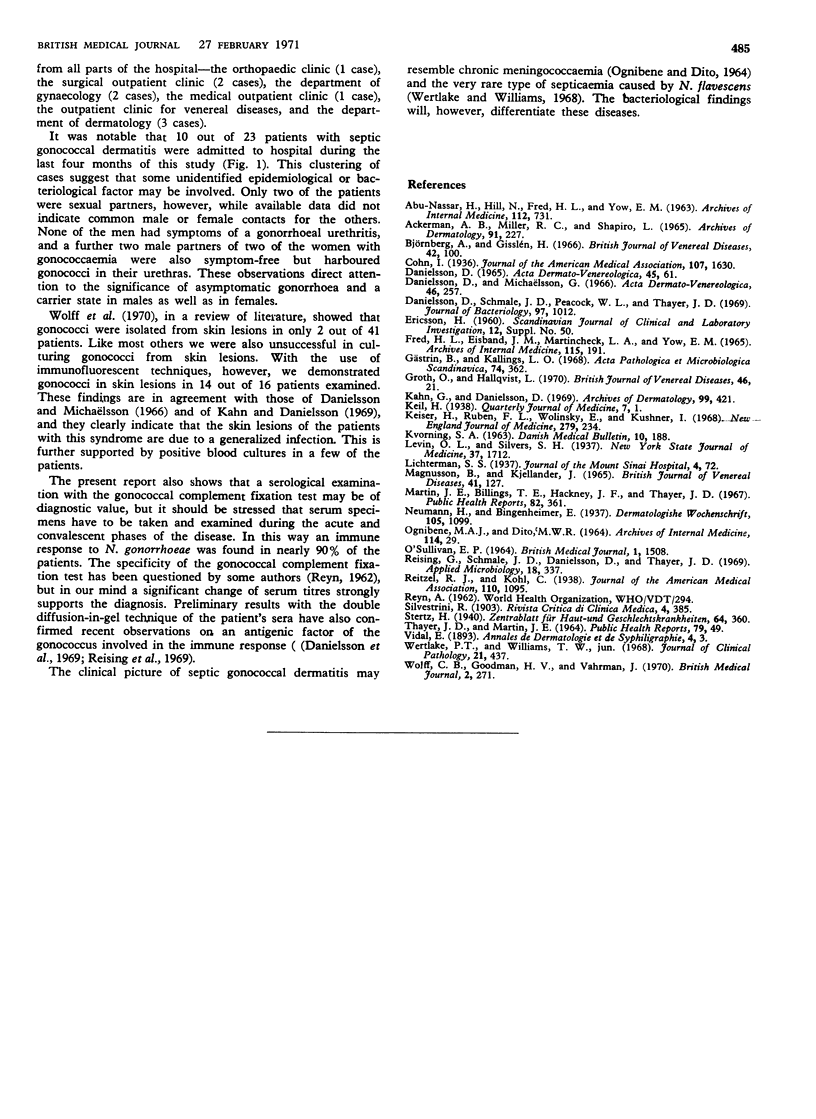Abstract
The overall incidence in gonorrhoea of septic gonococcal dermatitis was found to be 1·9% (3% for the females and 0·7% for the males). In 23 patients the common presenting symptoms were arthritis or arthralgia and bouts of fever, but the characteristic skin lesions served as an early clue to the diagnosis, and Neisseria gonorrhoeae was isolated from the genitourinary tract or from the blood. With the use of immunofluorescent techniques gonococci were also found in smears prepared from the skin lesions. An immune response to gonococci was found with the complement fixation technique in 90% of the patients. The response to treatment with penicillin was prompt, with complete relief from joint pains and fever, usually within two to seven days. The skin lesions faded within a few days, but scars could be observed for up to four weeks.
Full text
PDF



Selected References
These references are in PubMed. This may not be the complete list of references from this article.
- ABU-NASSAR H., HILL N., FRED H. L., YOW E. M. CUTANEOUS MANIFESTATIONS OF GONOCOCCEMIA. A REVIEW OF 14 CASES. Arch Intern Med. 1963 Nov;112:731–737. doi: 10.1001/archinte.1963.03860050118013. [DOI] [PubMed] [Google Scholar]
- ACKERMAN A. B., MILLER R. C., SHAPIRO L. GONOCOCCEMIA AND ITS CUTANEOUS MANIFESTATIONS. Arch Dermatol. 1965 Mar;91:227–232. doi: 10.1001/archderm.1965.01600090035006. [DOI] [PubMed] [Google Scholar]
- Björnberg A., Gisslén H. Benign gonococcal sepsis with skin lesions. Br J Vener Dis. 1966 Jun;42(2):100–102. [PMC free article] [PubMed] [Google Scholar]
- Danielsson D. G., Schmale J. D., Peacock W. L., Jr, Thayer J. D. Antigens of Neisseria gonorrhoeae: characterization by gel filtration, complement fixation, and agar-gel diffusion of antigens of gonococcal protoplasm. J Bacteriol. 1969 Mar;97(3):1012–1017. doi: 10.1128/jb.97.3.1012-1017.1969. [DOI] [PMC free article] [PubMed] [Google Scholar]
- Danielsson D. The demonstration of N. gonorrhoeae with the aid of fluorescent antibodies. 5. A comparison of different techniques--absorption, one-step inhibition, and counterstaining--for elimination of cross reactions. Acta Derm Venereol. 1965;45(1):61–73. [PubMed] [Google Scholar]
- FRED H. L., EIBAND J. M., MARTINCHECK L. A., YOW E. M. MORE ON GONOCOCCAL DERMATITIS. Arch Intern Med. 1965 Feb;115:191–191. doi: 10.1001/archinte.1965.03860140071015. [DOI] [PubMed] [Google Scholar]
- Gästrin B., Kallings L. O. Improved methods for gonococcal sampling and examination on a large scale. Acta Pathol Microbiol Scand. 1968;74(3):362–370. doi: 10.1111/j.1699-0463.1968.tb03489.x. [DOI] [PubMed] [Google Scholar]
- KVORNING S. A. ACUTE SKIN ERUPTIONS IN GENERALIZED GONORRHOEA. Dan Med Bull. 1963 Oct;10:188–190. [PubMed] [Google Scholar]
- Kahn G., Danielsson D. Septic gonococcal dermatitis. Demonstration of gonococci and gonococcal antigens in skin lesions by immunofluorescence. Arch Dermatol. 1969 Apr;99(4):421–425. doi: 10.1001/archderm.99.4.421. [DOI] [PubMed] [Google Scholar]
- Keiser H., Ruben F. L., Wolinsky E., Kushner I. Clinical forms of gonococcal arthritis. N Engl J Med. 1968 Aug 1;279(5):234–240. doi: 10.1056/NEJM196808012790503. [DOI] [PubMed] [Google Scholar]
- MAGNUSSON B., KJELLANDER J. GONOCOCCAL COMPLEMENT-FIXATION TEST IN COMPLICATED AND UNCOMPLICATED GONORRHOEA. Br J Vener Dis. 1965 Jun;41:127–151. doi: 10.1136/sti.41.2.127. [DOI] [PMC free article] [PubMed] [Google Scholar]
- Martin J. E., Jr, Billings T. E., Hackney J. F., Thayer J. D. Primary isolation of N. gonorrhoeae with a new commercial medium. Public Health Rep. 1967 Apr;82(4):361–363. [PMC free article] [PubMed] [Google Scholar]
- O'SULLIVAN E. P. GONORRHOEA IN THE SKIN. Br Med J. 1964 Jun 6;1(5396):1508–1508. doi: 10.1136/bmj.1.5396.1508-c. [DOI] [PMC free article] [PubMed] [Google Scholar]
- REYN A. Comparative investigation with dilution and diffusion methods of gonococcal sensitivity to antibiotics. II. Technical aspects. Acta Pathol Microbiol Scand Suppl. 1962;Suppl 154:294–295. [PubMed] [Google Scholar]
- Reising G., Schmale J. D., Danielsson D. G., Thayer J. D. Reactivity of two selected antigens of Neisseria gonorrhoeae. Appl Microbiol. 1969 Sep;18(3):337–339. doi: 10.1128/am.18.3.337-339.1969. [DOI] [PMC free article] [PubMed] [Google Scholar]
- THAYER J. D., MARTIN J. E., Jr A SELECTIVE MEDIUM FOR THE CULTIVATION OF N. GONORRHOEAE AND N. MENINGITIDIS. Public Health Rep. 1964 Jan;79:49–57. [PMC free article] [PubMed] [Google Scholar]
- Wertlake P. T., Williams T. W., Jr Septicaemia caused by Neisseria flavescens. J Clin Pathol. 1968 Jul;21(4):437–439. doi: 10.1136/jcp.21.4.437. [DOI] [PMC free article] [PubMed] [Google Scholar]
- Wolff C. B., Goodman H. V., Vahrman J. Gonorrhoea with skin and joint manifestations. Br Med J. 1970 May 2;2(5704):271–273. doi: 10.1136/bmj.2.5704.271. [DOI] [PMC free article] [PubMed] [Google Scholar]


